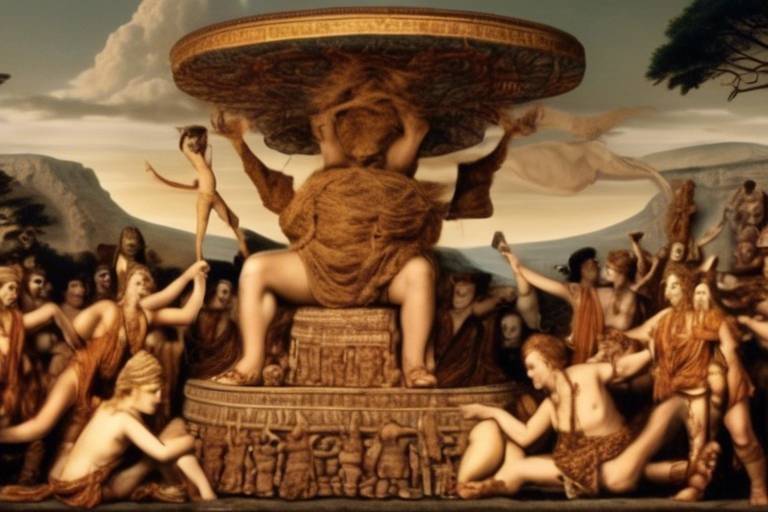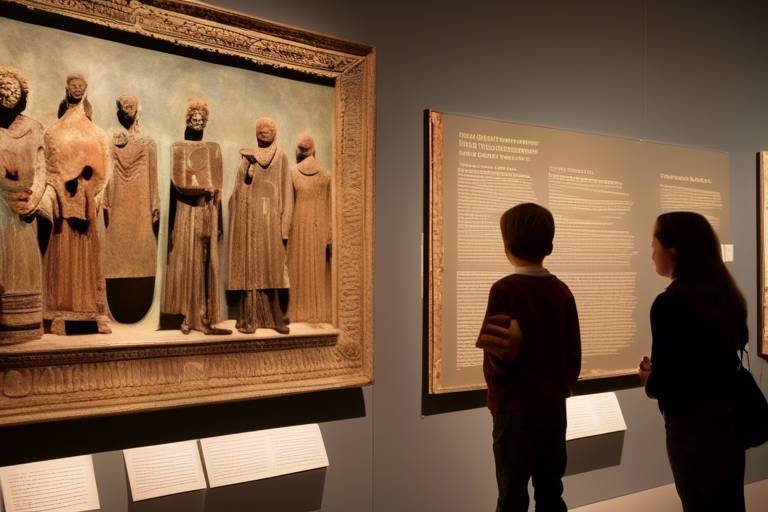Exploring the Seven Wonders of the Ancient World
The ancient world holds within its depths a treasure trove of architectural marvels that have stood the test of time, captivating generations with their grandeur and mystique. Among these wonders, the Seven Wonders of the Ancient World stand out as shining examples of human ingenuity and creativity. Each wonder tells a story of ancient civilizations and their remarkable achievements, offering a glimpse into a bygone era filled with awe-inspiring structures and artistic masterpieces.
Embark on a journey through history as we delve into the secrets and significance of these legendary wonders, marveling at the engineering feats and cultural importance they represent. From the majestic Great Pyramid of Giza to the towering Colossus of Rhodes, each wonder has a unique tale to tell, drawing us into the captivating world of ancient architecture and artistry.
Join us as we explore the wonders that have withstood the sands of time, defying the odds to stand as testaments to the brilliance of ancient civilizations. Let's unravel the mysteries and marvels of the Seven Wonders of the Ancient World, stepping back in time to witness the awe-inspiring creations that continue to inspire wonder and admiration to this day.

The Great Pyramid of Giza
The Great Pyramid of Giza stands as an enduring symbol of ancient Egypt's architectural prowess and cultural legacy. Built over 4,500 years ago, this monumental structure is the sole survivor of the original Seven Wonders of the World, captivating all who gaze upon its majestic form. The pyramid's sheer size and precision in construction continue to baffle historians and engineers alike, with each massive stone block meticulously placed to create a marvel of ancient engineering.
Constructed as a tomb for the Pharaoh Khufu, the Great Pyramid is a testament to the ingenuity and dedication of the ancient Egyptians. Its alignment with the cardinal points of the compass and the mathematical precision of its dimensions reflect a deep understanding of astronomy and geometry. Theories abound regarding the methods used to quarry, transport, and position the massive limestone blocks that form this architectural marvel, adding to the aura of mystery that surrounds the pyramid.
Visitors to the Great Pyramid of Giza are often struck by the sense of awe and wonder that emanates from its ancient stones. Exploring the intricate passageways and chambers within the pyramid offers a glimpse into the funerary practices and beliefs of the ancient Egyptians, shedding light on their complex religious rituals and reverence for the afterlife.
Surrounded by myths and legends, the Great Pyramid of Giza continues to capture the imagination of people around the world. From theories about hidden chambers and secret passageways to speculation about its alignment with celestial bodies, the pyramid remains a source of fascination and intrigue for historians, archaeologists, and curious minds alike.

Hanging Gardens of Babylon
The ancient world was home to remarkable architectural and artistic achievements. This article delves into the history and significance of the Seven Wonders, showcasing the ingenuity and craftsmanship of civilizations long past.
As the only Wonder still standing today, the Great Pyramid of Giza in Egypt continues to awe visitors with its grandeur and mystery, serving as a testament to the engineering prowess of the ancient Egyptians.
Often described as a lush oasis in the desert, the Hanging Gardens of Babylon are shrouded in myth and legend. Explore the enigmatic beauty and engineering marvel of this ancient wonder.
A masterpiece of classical Greek artistry, the Statue of Zeus at Olympia was a symbol of divine power and human creativity. Uncover the history and significance of this awe-inspiring sculpture.
Dedicated to the goddess Artemis, the Temple of Artemis at Ephesus was a marvel of ancient architecture and a center of religious devotion. Discover the splendor and cultural importance of this sacred site.
The Mausoleum at Halicarnassus was a monumental tomb built to honor Mausolus, a Persian satrap. Delve into the architectural beauty and historical significance of this ancient funerary structure.
Standing tall at the entrance of the harbor of Rhodes, the Colossus of Rhodes was a colossal statue that embodied the spirit of victory and resilience. Learn about the construction and symbolism of this iconic monument.
Guiding sailors through the ancient Mediterranean waters, the Lighthouse of Alexandria was a beacon of hope and safety. Explore the engineering marvel and maritime importance of this historic lighthouse.
The Hanging Gardens of Babylon, one of the most intriguing wonders of the ancient world, have captured the imagination of historians and archaeologists for centuries. Legend has it that the gardens were built by King Nebuchadnezzar II for his queen, Amytis, who missed the green hills and valleys of her homeland. These lush gardens were an architectural marvel, with terraces filled with exotic plants and trees irrigated by a complex system of water channels.

Statue of Zeus at Olympia
The ancient world was home to remarkable architectural and artistic achievements. This article delves into the history and significance of the Seven Wonders, showcasing the ingenuity and craftsmanship of civilizations long past.
As the only Wonder still standing today, the Great Pyramid of Giza in Egypt continues to awe visitors with its grandeur and mystery, serving as a testament to the engineering prowess of the ancient Egyptians.
Often described as a lush oasis in the desert, the Hanging Gardens of Babylon are shrouded in myth and legend. Explore the enigmatic beauty and engineering marvel of this ancient wonder.
A masterpiece of classical Greek artistry, the Statue of Zeus at Olympia was a symbol of divine power and human creativity. Uncover the history and significance of this awe-inspiring sculpture.
Dedicated to the goddess Artemis, the Temple of Artemis at Ephesus was a marvel of ancient architecture and a center of religious devotion. Discover the splendor and cultural importance of this sacred site.
The Mausoleum at Halicarnassus was a monumental tomb built to honor Mausolus, a Persian satrap. Delve into the architectural beauty and historical significance of this ancient funerary structure.
Standing tall at the entrance of the harbor of Rhodes, the Colossus of Rhodes was a colossal statue that embodied the spirit of victory and resilience. Learn about the construction and symbolism of this iconic monument.
Guiding sailors through the ancient Mediterranean waters, the Lighthouse of Alexandria was a beacon of hope and safety. Explore the engineering marvel and maritime importance of this historic lighthouse.
Stay tuned for the Frequently Asked Questions section coming soon!

Temple of Artemis at Ephesus
The Temple of Artemis at Ephesus, dedicated to the goddess Artemis, was a marvel of ancient architecture that stood as a testament to the religious devotion and artistic skill of the ancient world. Located in present-day Turkey, this grand temple was one of the largest and most magnificent structures of its time, attracting pilgrims and visitors from far and wide.
Constructed around 550 BC, the Temple of Artemis was adorned with intricate sculptures and adorned with precious metals, reflecting the wealth and cultural sophistication of the city of Ephesus. Its grandeur and size were unparalleled, making it a focal point of religious worship and a symbol of prosperity and power.
The temple was supported by a forest of marble columns, each intricately carved with scenes from mythology and history. The sheer scale of the structure, with its massive dimensions and elaborate decorations, left spectators in awe of the craftsmanship and artistic vision of its builders.
Visitors to the Temple of Artemis would have been greeted by the sight of the grand altar, where offerings and sacrifices were made to honor the goddess Artemis. The temple complex also housed various treasures and artifacts, further enhancing its status as a sacred and revered site.
Despite its grandeur, the Temple of Artemis faced destruction and reconstruction multiple times throughout its history, with various invaders and natural disasters taking their toll on the magnificent structure. Today, only a few remnants and ruins remain, serving as a poignant reminder of the once-great temple that stood as a beacon of religious and architectural achievement.

Mausoleum at Halicarnassus
The Mausoleum at Halicarnassus, one of the Seven Wonders of the Ancient World, stood as a testament to the grandeur and artistry of ancient architecture. Built in the city of Halicarnassus, present-day Bodrum in Turkey, this monumental tomb was constructed in honor of Mausolus, a Persian satrap, and his wife Artemisia.
The Mausoleum was a fusion of various architectural styles, showcasing intricate sculptures and elaborate decorations that adorned its facade. The sheer size and beauty of the structure reflected the power and wealth of Mausolus, making it a symbol of prestige and remembrance for centuries to come.
Surrounded by a courtyard and featuring a stepped pyramid topped with a chariot statue, the Mausoleum at Halicarnassus was a marvel of ancient funerary art. The detailed friezes and statues that adorned the monument depicted scenes from mythology and history, adding a rich narrative to its already impressive architecture.
Visitors to the Mausoleum marveled at the craftsmanship and dedication that went into its construction. The sheer scale of the structure, standing over 45 meters tall, evoked a sense of awe and reverence for the ancient artisans who brought Mausolus' final resting place to life.
Despite suffering damage from earthquakes over the centuries, the Mausoleum at Halicarnassus remained a symbol of architectural achievement and cultural significance. Its legacy lives on through historical accounts and archaeological discoveries, offering a glimpse into the artistic and engineering prowess of the ancient world.

Colossus of Rhodes
The Colossus of Rhodes was a monumental statue located at the entrance of the harbor of Rhodes, a symbol of victory and resilience for the ancient city. This awe-inspiring statue, depicting the Greek sun god Helios, stood tall and proud, captivating all who laid eyes upon it. Constructed from bronze and iron, the Colossus of Rhodes was a marvel of ancient engineering, showcasing the skill and dedication of the craftsmen who brought it to life.
Standing over 100 feet high, the Colossus of Rhodes was a beacon of strength and power, representing the indomitable spirit of the people of Rhodes. Its construction was a feat of monumental proportions, with intricate details and artistic finesse that highlighted the artistic prowess of the ancient world. The statue's significance extended beyond its physical presence, embodying the ideals of victory and protection that the people of Rhodes held dear.
Despite its grandeur, the Colossus of Rhodes stood for only a few decades before being toppled by an earthquake in 226 BC. The remnants of this legendary statue lay scattered for centuries, a poignant reminder of the transient nature of human achievements. However, the legacy of the Colossus of Rhodes lives on in the annals of history, immortalizing the spirit of resilience and triumph that it once symbolized.

Lighthouse of Alexandria
The ancient world was home to remarkable architectural and artistic achievements. This article delves into the history and significance of the Seven Wonders, showcasing the ingenuity and craftsmanship of civilizations long past.
As the only Wonder still standing today, the Great Pyramid of Giza in Egypt continues to awe visitors with its grandeur and mystery, serving as a testament to the engineering prowess of the ancient Egyptians.
Often described as a lush oasis in the desert, the Hanging Gardens of Babylon are shrouded in myth and legend. Explore the enigmatic beauty and engineering marvel of this ancient wonder.
A masterpiece of classical Greek artistry, the Statue of Zeus at Olympia was a symbol of divine power and human creativity. Uncover the history and significance of this awe-inspiring sculpture.
Dedicated to the goddess Artemis, the Temple of Artemis at Ephesus was a marvel of ancient architecture and a center of religious devotion. Discover the splendor and cultural importance of this sacred site.
The Mausoleum at Halicarnassus was a monumental tomb built to honor Mausolus, a Persian satrap. Delve into the architectural beauty and historical significance of this ancient funerary structure.
Standing tall at the entrance of the harbor of Rhodes, the Colossus of Rhodes was a colossal statue that embodied the spirit of victory and resilience. Learn about the construction and symbolism of this iconic monument.
Guiding sailors through the ancient Mediterranean waters, the Lighthouse of Alexandria was a beacon of hope and safety. Explore the engineering marvel and maritime importance of this historic lighthouse.
Frequently Asked Questions
- What are the Seven Wonders of the Ancient World?
The Seven Wonders of the Ancient World were a collection of remarkable constructions in the ancient Mediterranean and Near East. These included the Great Pyramid of Giza, the Hanging Gardens of Babylon, the Statue of Zeus at Olympia, the Temple of Artemis at Ephesus, the Mausoleum at Halicarnassus, the Colossus of Rhodes, and the Lighthouse of Alexandria.
- Why are the Seven Wonders of the Ancient World significant?
The Seven Wonders represent the ingenuity, architectural prowess, and cultural achievements of ancient civilizations. They serve as a testament to human creativity, engineering capabilities, and the grandeur of the past. Each Wonder holds a unique historical and cultural significance that continues to captivate people worldwide.
- Which of the Seven Wonders of the Ancient World still exist today?
Among the Seven Wonders, only the Great Pyramid of Giza in Egypt remains standing to this day. Despite the passage of millennia, this architectural marvel continues to stand as a symbol of the ancient Egyptians' mastery in engineering and construction.
- What happened to the other Six Wonders of the Ancient World?
The other Six Wonders of the Ancient World have been lost to time, with various factors such as natural disasters, wars, and human activities contributing to their destruction. While their physical remains may no longer exist, their legacy lives on through historical records, archaeological findings, and artistic representations.



















